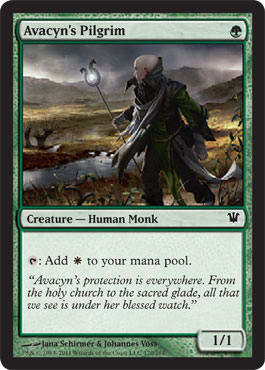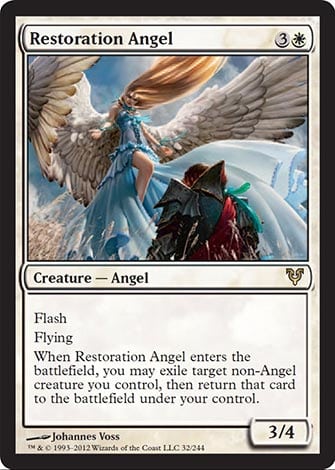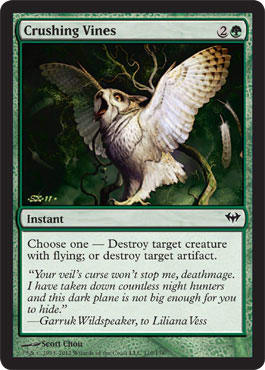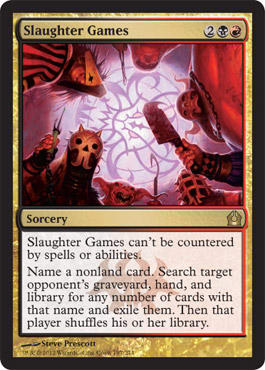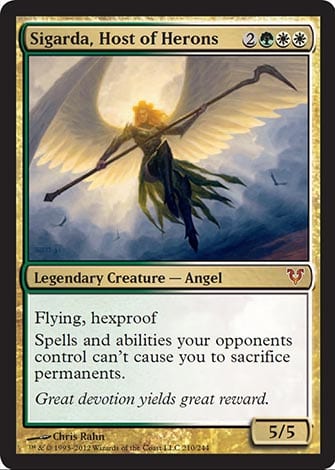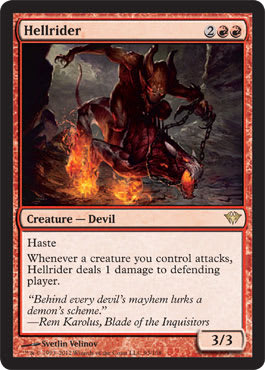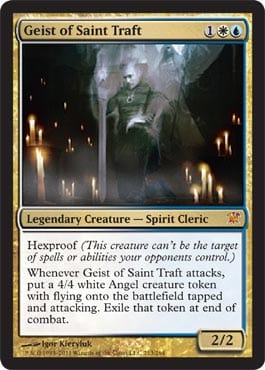Hey, everyone!
Last week, I discussed my favorite deck in Standard, Bant midrange. Although I’m comfortable with the deck, I wanted to try some other decks and improve my perspective of the format. After playing some new decks, I can safely say I have a new view on Standard.
Remember the Naya deck I posted last week? Adam Witton placed second with this hunk of fat at Grand Prix: Auckland:
"Adam Witton’s Naya"
- Creatures (19)
- 3 Angel of Serenity
- 4 Avacyn's Pilgrim
- 4 Huntmaster of the Fells
- 4 Restoration Angel
- 4 Thragtusk
- Planeswalkers (3)
- 3 Garruk, Primal Hunter
- Spells (12)
- 2 Selesnya Charm
- 1 Devil's Play
- 2 Bonfire of the Damned
- 4 Farseek
- 3 Oblivion Ring
- Lands (26)
- 3 Mountain
- 4 Forest
- 2 Kessig Wolf Run
- 3 Clifftop Retreat
- 3 Rootbound Crag
- 3 Selesnya Guildgate
- 4 Sunpetal Grove
- 4 Temple Garden
- Sideboard (15)
- 1 Bonfire of the Damned
- 1 Centaur Healer
- 1 Devil's Play
- 1 Garruk, Primal Hunter
- 3 Loxodon Smiter
- 1 Ray of Revelation
- 2 Rest in Peace
- 2 Sigarda, Host of Herons
- 1 Terminus
- 2 Zealous Conscripts
Even if I didn’t end up loving the deck, I learned a lot about pushing midrange to the limit. This deck improves on the ramping of Bant with the addition of Avacyn's Pilgrim. Rather than play an abundance of early drops, Naya just wants to ramp on turn one or two for an early Huntmaster of the Fells.
Naya would also answer the question, “Can you play tri-colored decks without two guilds?” I think the answer is “yes,” but notice how red is basically a splash for Kessig Wolf Run, Bonfire of the Damned, and Huntmaster of the Fells.
Since I had Sunpetal Grove, Temple Garden, Selesnya Guildgate, and even Avacyn's Pilgrim, it was easy to access green and white mana. Red was challenging since I had to use Farseek to find a basic Mountain (I miss Stomping Ground!). The Devil's Play was about as awkward as you would expect because of this. Flashing it back was rarely an option, and Kessig Wolf Run did the same thing anyway.
Restoration Angel was impressive in the midgame, but it wasn’t the creature I want to ramp into on turn three. I think this deck wants a threat that’s worth playing early—such as Garruk Relentless—against decks that shrug off Huntmaster of the Fells. Although Garruk does something very similar to Huntmaster of the Fells, the threat of continually generating a Wolf can be effective against Supreme Verdict.
Thragtusk (#Swagtusk) was obviously impressive in this deck, but Selesnya Charm was a weak answer to opposing copies. In nearly every game I drew the Charm, I wished it had been something more powerful. Something to note is that you have thirty-four mana sources (twenty-six lands, four Farseek, and four Avacyn's Pilgrim), so each spell has to matter. On the other hand, you still need early plays against aggressive starts.
The Charm was hyped as a way to deal with Angel of Serenity, Thragtusk, and Thundermaw Hellkite, but those creatures aren’t as prevalent as you may expect. Out of those three, the only one I consistently see is Thragtusk and charming that Beast is not impressive.
Here’s the list I would suggest:
"New Naya"
- Creatures (19)
- 1 Armada Wurm
- 2 Angel of Serenity
- 4 Avacyn's Pilgrim
- 4 Huntmaster of the Fells
- 4 Restoration Angel
- 4 Thragtusk
- Planeswalkers (4)
- 2 Garruk Relentless
- 2 Garruk, Primal Hunter
- Spells (11)
- 3 Bonfire of the Damned
- 4 Farseek
- 4 Oblivion Ring
- Lands (26)
- 3 Forest
- 3 Mountain
- 2 Cavern of Souls
- 2 Clifftop Retreat
- 2 Kessig Wolf Run
- 2 Selesnya Guildgate
- 4 Rootbound Crag
- 4 Sunpetal Grove
- 4 Temple Garden
- Sideboard (15)
- 2 Rest in Peace
- 2 Crushing Vines
- 3 Terminus
- 3 Centaur Healer
- 1 Ray of Revelation
- 2 Sigarda, Host of Herons
- 2 Zealous Conscripts
Since Detention Sphere has been seeing less and less play, I think it’s alright to main-deck four Oblivion Ring. In this list, you have twenty-six spells that you’re happy to draw in the late game, which makes this deck very scary to face.
I added a couple Cavern of Souls because Adam Prosak’s W/U control deck is starting to gain steam:
"Adam Prosak’s W/U Flash"
- Creatures (12)
- 4 Augur of Bolas
- 4 Restoration Angel
- 4 Snapcaster Mage
- Spells (25)
- 1 Rewind
- 1 Sphinx's Revelation
- 2 Dissipate
- 2 Essence Scatter
- 2 Syncopate
- 3 Think Twice
- 4 Azorius Charm
- 4 Thought Scour
- 4 Unsummon
- 2 Runechanter's Pike
- Lands (23)
- 4 Plains
- 9 Island
- 2 Moorland Haunt
- 4 Glacial Fortress
- 4 Hallowed Fountain
- Sideboard (15)
- 3 Detention Sphere
- 1 Erase
- 2 Faith's Shield
- 1 Negate
- 2 Purify the Grave
- 1 Rewind
- 3 Geist of Saint Traft
- 2 Supreme Verdict
The reason I think Crushing Vines is becoming a great sideboard card is that it answers Restoration Angel, Runechanter's Pike, and even Thundermaw Hellkite.
Rest in Peace is also a great sideboard card against this deck because it affects Think Twice, Snapcaster Mage, Runechanter's Pike, and Moorland Haunt. The only way the deck can win once the enchantment is in play is with Restoration Angel, Snapcaster Mage, and Augur of Bolas.
This deck is very beatable, and you can expect to face it frequently at higher-level events. Loxodon Smiter is another sideboard option to add to the uncounterable threat count, but I think Crushing Vines is the way to go because the deck’s player will board in Supreme Verdict anyway.
Selesnya Charm is also falling out of favor with me because this W/U deck is absorbing the popularity of R/W/U midrange. The Charm only hits creatures enchanted with the Pike, but my goal is to make sure the Equipment never comes online.
The Naya deck is extremely fun because you essentially cast a ridiculously powerful spell every turn. I want to apply this strategy to a deck that has recently fallen in popularity: Jund. The main problem with Jund was that the abundance of removal kept it from drawing relevant spells in the late game. Why play so much removal when you can simply play a ton of bombs?
"Standard Jund"
- Creatures (11)
- 4 Huntmaster of the Fells
- 4 Thragtusk
- 3 Olivia Voldaren
- Planeswalkers (5)
- 1 Garruk Relentless
- 2 Garruk, Primal Hunter
- 2 Liliana of the Veil
- Spells (19)
- 1 Searing Spear
- 2 Ultimate Price
- 2 Dreadbore
- 2 Rakdos's Return
- 2 Sever the Bloodline
- 3 Bonfire of the Damned
- 4 Farseek
- 3 Rakdos Keyrune
- Lands (25)
- 1 Forest
- 1 Mountain
- 1 Swamp
- 2 Kessig Wolf Run
- 4 Blood Crypt
- 4 Dragonskull Summit
- 4 Overgrown Tomb
- 4 Rootbound Crag
- 4 Woodland Cemetery
- Sideboard (15)
- 2 Slaughter Games
- 3 Pillar of Flame
- 3 Deathrite Shaman
- 2 Underworld Connections
- 3 Duress
- 2 Thundermaw Hellkite
I don’t typically like cards you use to preemptively stop something from happening such as Pithing Needle, Slaughter Games, or Surgical Extraction, but you need to remove Sphinx's Revelation from Bant decks. You can also name Angel of Serenity against reanimator, but be careful not to be trigger-happy with this card. If you spend a card and a turn in a midrange mirror to remove the opponent’s Thragtusks, you aren’t actually doing very much unless you pull one out of his hand.
The primary innovation in current Jund deck is the absence of main-decked Pillar of Flame. There was a time when Zombies ran rampant and the spell was a necessity, but this is a time of midrange and control. That’s not to say there isn’t the occasional beatdown deck, but you still have the tools to answer threats in the main deck.
Rather than play a ton of removal that simply trade one for one, I have Bonfire of the Damned, Sever the Bloodline, Garruk Relentless, and Liliana of the Veil. It can be easy to forget about Geist of Saint Traft until it kills you, so plan ahead, and don’t let that happen—play some main-decked answers.
A draw to playing black is Ultimate Price over Selesnya Charm. The ability to kill Thragtusk, Angel of Serenity, and Thundermaw Hellkite is complemented by the option to destroy Restoration Angel and early aggro threats. The lack of instant-speed removal was always an issue for Jund, and this card isn’t receiving the love it deserves.
Another card I can see increasing in popularity is Sigarda, Host of Herons. It’s under the radar thanks to Thragtusk pushing it out of the spotlight, but it’s very strong. It also increases the value of Cavern of Souls because you can name Angel to sneak in Restoration Angel, then Sigarda, and finally Angel of Serenity. Midrange decks need to answer this creature; my only option is Bonfire of the Damned.
The reason I like this deck more than Naya is that you have access to eight shock lands. Although they aren’t a necessity, the mana is certainly much smoother. The Rakdos Keyrune is also the most powerful of the cycle, so you can play more mana sources without feeling flooded in the late game. Avacyn's Pilgrim is nice for Kessig Wolf Run, but it’s not the best top-deck in the world.
I have all three basic lands in the deck because Kessig Wolf Run and Underworld Connections will force your opponent to activate Ghost Quarter. I wouldn’t want that to color screw me, so it can possibly fix my mana in the process. Don’t forget that playing twelve core-set duals has its cost as well. A few basics never hurt anybody.
As promised, I also want to briefly talk about my Bant midrange updates:
"Bant Midrange Updates"
- Creatures (11)
- 2 Angel of Serenity
- 2 Restoration Angel
- 2 Snapcaster Mage
- 4 Thragtusk
- 1 Sigarda, Host of Herons
- Planeswalkers (5)
- 2 Tamiyo, the Moon Sage
- 3 Jace, Architect of Thought
- Spells (19)
- 3 Azorius Charm
- 3 Dissipate
- 3 Sphinx's Revelation
- 3 Supreme Verdict
- 4 Farseek
- 3 Detention Sphere
- Lands (25)
- 1 Plains
- 3 Island
- 1 Cavern of Souls
- 4 Glacial Fortress
- 4 Hallowed Fountain
- 4 Hinterland Harbor
- 4 Sunpetal Grove
- 4 Temple Garden
- Sideboard (15)
- 2 Rest in Peace
- 1 Cavern of Souls
- 2 Negate
- 3 Centaur Healer
- 3 Geist of Saint Traft
- 3 Terminus
- 1 Ray of Revelation
I cut a Cavern of Souls since I was having issues casting early Dissipates and Azorius Charms. The second copy only went to the sideboard, so I can force through Angels against W/U Flash.
Since most of the large creatures from G/W aggro were making Restoration Angel a mere chump-blocker, I went to two copies. I made room for a Sigarda since it’s one of my favorite cards in the format for the time being.
Adding a third Sphinx's Revelation has made the deck a thousand times better since I typically have gas at any point in the game. I can flash it back with Snapcaster Mage, so I essentially have five copies. This makes it an acceptable 5-drop so I don’t have to Time Walk myself to generate maximum value.
Another big change to the deck is that I cut down to three Jaces. If I had multiple Jaces, I tended to become wasteful; there’s no reason to have to kill off your Jace in order to cast a stranded copy in hand. The addition of a third Sphinx's Revelation means I had more card-drawing effects, which means I needed to add more cards that actually win the game.
I don’t want to spend this entire article talking about midrange because there was actually a deck I saw that looked interesting that played a bunch of Mountains.
"Mono-Red Aggro"
- Creatures (28)
- 2 Pyreheart Wolf
- 3 Rakdos Shred-Freak
- 3 Stonewright
- 4 Ash Zealot
- 4 Gore-House Chainwalker
- 4 Hellrider
- 4 Rakdos Cackler
- 4 Stromkirk Noble
- Spells (10)
- 2 Brimstone Volley
- 4 Searing Spear
- 4 Pillar of Flame
- Lands (22)
- 21 Mountain
- 1 Hellion Crucible
- Sideboard (15)
- 2 Archwing Dragon
- 2 Brimstone Volley
- 3 Flames of the Firebrand
- 4 Mark of Mutiny
- 1 Pyreheart Wolf
- 1 Stonewright
- 2 Volcanic Strength
Not only is this deck incredibly cheap to build, Hellrider is secretly one of the most powerful cards in Standard. While everyone is caught up in the hype of midrange (take me for example), Red Deck Wins can actually fight Thragtusk as odd as it sounds.
Pyreheart Wolf not only survives removal spells, but the wording prevents you from being blown out in combat. Your creatures still must be blocked by two creatures when it dies once it attacked. Thragtusk isn’t good for anything except blocking in this matchup because this deck is so aggressive.
Archwing Dragon out of the sideboard is an interesting idea against sorcery-speed-removal decks such as Jund. The fact that this card is in the sideboard is a testament to the hole in most midrange decks. RDW preys on the fact that these tri-color decks have to wait a turn before they answer cards such as Hellrider.
I lost two matches in a row with various midrange decks to RDW because of Brimstone Volley and Hellrider. One of the threats I was concerned about was Hellion Crucible. I could see going up to two copies because it plays a similar role as Archwing Dragon (haste damage out of nowhere).
Zombies also made a comeback at StarCityGames: Dallas by making the Top 16. It’s a start—we haven’t seen the black beaters do anything for weeks. Here’s Alan Chavez’s list:
"Alan Chavez’s Zombies"
- Creatures (24)
- 4 Blood Artist
- 4 Diregraf Ghoul
- 4 Falkenrath Aristocrat
- 4 Geralf's Messenger
- 4 Gravecrawler
- 4 Rakdos Cackler
- Spells (15)
- 4 Brimstone Volley
- 4 Searing Spear
- 3 Pillar of Flame
- 4 Bump in the Night
- Lands (21)
- 10 Swamp
- 3 Blood Crypt
- 4 Dragonskull Summit
- 4 Rakdos Guildgate
- Sideboard (15)
- 2 Underworld Connections
- 1 Cremate
- 2 Rakdos Charm
- 2 Ultimate Price
- 2 Rakdos, Lord of Riots
- 2 Dreadbore
- 1 Pillar of Flame
- 1 Sever the Bloodline
- 2 Slaughter Games
As the W/U Flash deck gains popularity, the number of Thragtusks have been decreasing. This puts red aggro decks in the best position we have seen in quite some time. I would assume Alan wasn’t able to find a fourth Blood Crypt since it appears to be strictly superior to Rakdos Guildgate.
Standard is at an interesting place right now. Will RDW or Zombies win out as the best all-in burn deck? I would say RDW has a fighting chance because Hellrider seems stronger than Falkenrath Aristocrat at this point. This could easily change if enough players pick up Ultimate Price and need a multicolored haste creature.
There are three midrange Thragtusk decks fighting for the top slot: Bant, Naya, and Jund. They each have their own merits, and I wouldn’t fault you for playing any of them. I think Naya is at a significant disadvantage due to the mana constraints, but it will be anyone’s game after Gatecrash is released.
The true control deck appears to be W/U Flash, as it took down SCG: Dallas. Since the colors could be an issue with R/W/U, I think straight Azorius is a good place to be. I tried a R/W/U deck that tried to fit the W/U Flash shell with Geist of Saint Traft, and it was a train wreck. If you want to play controlling cards such as Rewind, make sure you know your role.
Thanks for reading,
Kyle













